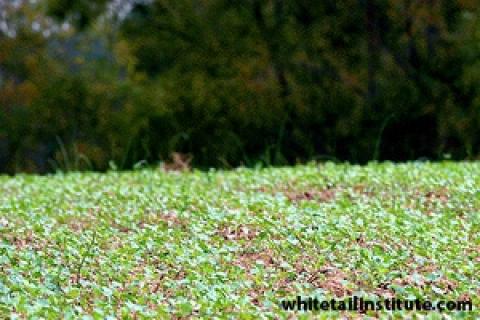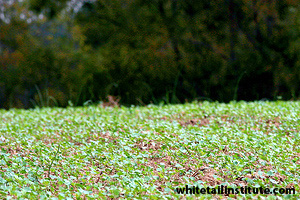
Every year it happens: spring springs and food plotters start a mad dash to get their planting done. Trouble is, the weather never seems to cooperate and there never seems to be enough time. You get only so many weekends to get your plots in, so a little advance work can make your life as a food plotter a whole lot easier. Here is what you should have ready to go by the time planting time rolls around.
Check Soil pH
 |
| Don't make selecting food plot seed difficult — pick a name brand out and follow instructions on the bag. |
It is imperative that you test your soil, and the pre-planting season is the time to do it. A good soil test will tell you if your soil is ready to be planted or needs to be amended with lime. It will also tell you what kind of fertilizer to apply if you tell them what you will be planting.
Soil testing is one of the simplest parts of the whole process. Dig down a few inches below the surface and take a few samples from around the plot. Mix them in a clean plastic bucket and dump some in a plastic sandwich bag. Take it to your local feed and seed store, ag extension office, or send it to the Whitetail Institute for analysis. You will have the analysis in a few days and you will know whether or not you need to amend your soil with lime and what mixture of fertilizer to use.
You generally will need to add lime to adjust the soil pH. as most of the time you are trying to "sweeten" up acidic soil. A reading of 7 is perfect pH for most food plot forages but most plants will do fine in anything over 6 on the scale. Anything below 6 (acid) should get a healthy dose of lime to begin raising the pH. Use quick acting lime if you will be planting this year.
Raising the pH of soil will allow nutrients to be released to plants as acidic soil "binds" nutrients and makes them inaccessible to plants. Spread a bag of fertilizer on acidic ( 4.5 -5.9) soil and very little of the fertilizer will be taken up by the plants. Spread the same bag on "sweet' (6.0-7) soil and most, if not all, of the fertilizer will be used by the plants.
Select Your Seed
Once you understand your soil, it's time to choose what kind of plants to grow. About 60 pprcent of your plots should be planted in perennials (re-grow year after year) and the remaining in annuals (grow one year and die). Perennial food plots can last up to 5 years before they are taken over by invasive grasses and weeds, while annuals grow for a season and die. Perennials are nice to have in place for spring green up as they are some of the first forages to pop up when the soil warms. Typically they are up and running by mid spring just and are a welcome shot of nutrition for whitetails just coming out of a tough winter.
You can make seed selection as difficult or as simple as you wish. We prefer simple. Basically, we pick up a bag of name brand pre-mixed food plot blend and follow the directions on the bag. We have had great luck with brand names like those carried in Bass Pro Shops. The hard way is to try to mix your own by buying raw seed from local feed and seed stores. Much of the seed they sell is designed for cattle forage, which does not always mean deer forage. You will also to inoculate certain seeds and be sure you plant in the right ratios, etc. Bottom line, mixing your own gets pretty tricky and you need some help unless you are very well versed on wildlife food plot forages.
Choosing plants and blends use to be pretty easy. You either planted clover, or clover. Not any more. What with the proliferation of food plot seed companies everyone has their own magic bean so to speak. Our day in day out favorite perennial (comes back every year) mix is a clover-chicory blend from the Whitetail Institute. Clover is the work horse of most food plot programs. They grow readily and deer love these perennials. Most deer clovers are easily digested and provide around 25% protein. Chicory does well in warm, dry weather and is great companion to clover. When the clover gets hot and tired, the chicory thrives.
When it comes to annuals (replant every year) we like a combo of brassicas and a grain like oats or rye. Brassicas is a food plot favorite which is often found in commercially developed blends. It will need to be reseeded every year but it is rich in nutrition, grows well, and deer love it in the late season after a freeze. In far northern climates you can plant your brassicas early and watch it grow all summer. In the south it is best put in as a fall planting. A good plot of brassicas will produce tons of deer nutrition per acre.
Line Up Your Fertilizer
If you have had a soil test done and told the lab what you want to plant in the plot you should have a fertilizer recommendation to work with. It is important to locate and perhaps locate your fertilizer in advance of the day you will need it.
Fertilizers are comprised of three critical elements: nitrogen (N), phosphorus (P) and potassium (K). Those are the three numbers you find on fertilizer bags (10-10-10) (0-20-15) or some other numerical combination indicates the proportion of each element found in the bag. Most food plot seed bags come with fertilizer recommendations which should be followed as closely as possible. And most companies bag fertilizer in standard configurations.
On the other hand, you may have to improvise. The lab report might recommend a combination that is extremely hard to find combination that must be custom mixed by a fertilizer distributor. Don't be surprised if you ask for 10 bags of some exotic blend for your half-acre plot and they just laugh. Custom blends are usually sold in large quantities, not in small quantities. They probably can set you up with something similar without too much difficulty so be prepared to be flexible.
Get your fertilizer early. Waiting until the last minute might just find you running all over the county looking for the right mix. Usually, since fertilizer is very seasonal, when it's out, it's out.
Ready, Set, Go
With everything lined up in advance, you'll be ready to get your plots in when those perfect planting conditions roll around sometime in spring. The best way to time your planting is to keep a close eye on the farmers in your neighborhood. They know dirt and they know weather. Chances are, if they are out working their fields, you should be doing the same. Having everything ready will in advance will keep you from driving all over town looking for stuff when you should be driving all over your food plot planting deer food.
Craig Dougherty's new book "Whitetails: From Ground to Gun" covers food plot planting and deer forages in detail. It can be found in most Bass Pro Shop stores or ordered at www.northcountrywhitetails.com
- 4035 views

